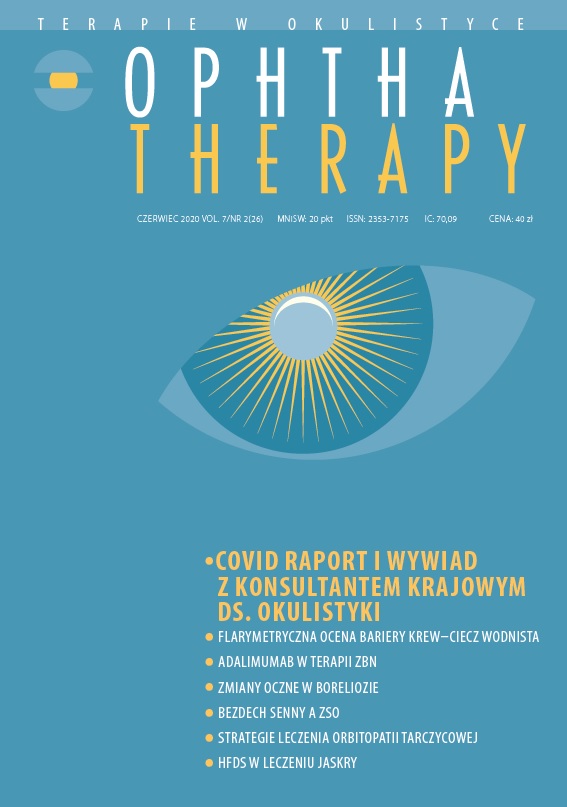Zoonoses in ophthalmology: Part III. Changes in the course of Lyme disease Review article
Main Article Content
Abstract
Borreliosis is a disease that was discovered in the 1970s, but its pathophysiological mechanisms and clinical course are not yet fully understood. The number of diagnosed Lyme disease cases in Poland has been increasing over the last decade. Poland has seen endemic Lyme disease, with one of the highest rates of infection in Europe. It is a zoonotic, vector-related disease that is transmitted by ticks that are infected with Borrelia burgdorferi spirochetes. One of the least known, poorly documented, and rarely recognized forms of Lyme disease is ocular borreliosis. Ocular alterations can occur in both the anterior and posterior segments of the eye, depending on the phase of the disease. In early stages when the tick bite is close to the eyeball, erythema-containing spirochetes can spread to the eyelids and conjunctiva of the eye per continuum. In the second phase when spirochetes spread throughout the whole body but have a predilection for nerve tissue, they occupy cranial nerves. This may also affect the optic nerve, less often oculomotor nerves and the retina. This phase of ocular borreliosis is associated with neuroborreliosis. In this stage, ocular borreliosis usually coexists with meningitis or encephalitis.
In addition to the history and clinical picture of Lyme disease, accurate diagnoses based on commercially available serological tests are fundamentally important in Poland. This article describes three phases of Lyme disease. We explain the reasons for its clinical differences in the old and new worlds from an epidemiological perspective. The clinical picture, treatment, and prognosis of Lyme disease are discussed.
Downloads
Article Details

This work is licensed under a Creative Commons Attribution-NonCommercial-NoDerivatives 4.0 International License.
Copyright: © Medical Education sp. z o.o. License allowing third parties to copy and redistribute the material in any medium or format and to remix, transform, and build upon the material, provided the original work is properly cited and states its license.
Address reprint requests to: Medical Education, Marcin Kuźma (marcin.kuzma@mededu.pl)
References
2. Burgdorfer W. Discovery of the Lyme disease spirochete and its relation to tick vectors. Yale J Biol Med. 57; 518-20: 1984.
3. Weber K. Aspects of Lyme Borreliosis in Europe. Eur J Clin Microbiol Infect Dis. 2001; 20(1): 0006-0013. https://doi.org/10.1007/s100960000412.
4. Strnad M, HönigV, Růžek D et al. Europe-Wide Meta-Analysis of Borrelia burgdorferi Sensu Lato Prevalence in Questing Ixodes ricinus Ticks. Appl Environ Microbiol. 2017; 83(15): e00609-17. https://doi.org/10.1128/AEM.00609-17.
5. Kahl O, Janetzki-Mittmann C, Gray JS et al. Risk of infection with Borrelia burgdorferi sensu lato for a host in relation to the duration of nymphal Ixodes ricinus feeding and the method of tick removal. Zentralbl Bakteriol. 1998; 287: 41-52.
6. de Silva AM, Fikrig E. Growth and migration of Borrelia burgdorferi in Ixodes ticks during blood feeding. Am J Trop Med Hyg. 1995; 53: 397-404.
7. Rauer S, Kastenbauer S, Hofmann H et al. Guidelines for diagnosis and treatment in neurology – Lyme neuroborreliosis. Ger Med Sci. 2020; 18: Doc03. Published 2020 Feb 27. https://doi.org/10.3205/000279.
8. Wójcik-Fatla A, Zając V, Sawczyn A et al. Infections and mixed infections with the selected species of Borrelia burgdorferi sensu lato complex in Ixodes ricinus ticks collected in eastern Poland: a significant increase in the course of 5 years. Exp Appl Acarol. 2016; 68: 197-212. https://doi.org/10.1007/s10493-015-9990-4.
9. Czarkowski MP, Cielebąk E, Kondej B et al. Infectious diseases and poisonings in Poland in 2018. Warsaw 2019, NIZP-PZH, GIS.
10. Zbrzeźniak J, Paradowska-Stankiewicz I. Lyme disease in Poland in 2017. Przegl Epidemiol. 2019; 73(3): 317‐20. https://doi.org/10.32394/pe.73.37.
11. Paradowska-Stankiewicz I, Chrześcijańska I. Lyme disease in Poland in 2015. Przegl Epidemiol. 2017; 71(4): 513‐7.
12. Brydak-Godowska J, Moskal K, Borkowski PK et al. A Retrospective Observational Study of Uveitis in a Single Center in Poland with a Review of Findings in Europe. Med Sci Monit. 2018; 24: 8734-49. https://doi.org/10.12659/MSM.910749.
13. Tran VT, Auer C, Guex-Crosier Y et al. Epidemiological characteristics of uveitis in Switzerland. Int Ophthalmol. 1994–1995; 18: 293-98.
14. Bodaghi B, Cassoux N, Wechsler B et al. Chronic severe uveitis: Aetiology and visual outcome in 927 patients from a single center. Medicine. 2001; 80: 263-70.
15. Grajewski RS, Caramoy A, Frank KF et al. Spectrum of uveitis in a Germany Tertiary Center: Review of 474 consecutive patients. Ocul Immunol Inflamm. 2015; 23: 346-52.
16. Błaut-Jurkowska J, Jurkowski M. Zespół poboreliozowy [Post-Lyme disease syndrome]. Pol Merkur Lekarski. 2016; 40(236): 129‐33.
17. Rebman AW, Aucott JN. Post-treatment Lyme Disease as a Model for Persistent Symptoms in Lyme Disease. Front Med (Lausanne). 2020; 7: 57. https://doi.org/10.3389/fmed.2020.00057.
18. Zalecenia PTEiLChZ. http://www.pteilchz.org.pl/informacje/rekomendacje.
19. Moniuszko A, Dunaj J, Zajkowska J et al. Comparison of detection of Borrelia burgdorferi DNA and anti-Borrelia burgdorferi antibodies in patients with erythema migrans in north-eastern Poland. Postepy Dermatol Alergol. 2015; 32(1): 11‐14. https://doi.org/10.5114/pdia.2014.40940.
20. Lebech AM, Hansen K, Brandrup F et al. Diagnostic Value of PCR for Detection of Borrelia burgdoferi DNA in Clinical Specimens From Patients With Erythrema Migrans and Lyme Neuroborreliosis. Mol Diag. 2000; 2: 139-50.

